玉米丝提取物对紫杉醇所致大鼠脊髓和坐骨神经损伤的影响:生化和组织学评价
IF 2
4区 医学
Q3 NEUROSCIENCES
引用次数: 0
摘要
肾素-血管紧张素系统(RAS)的过度激活与氧化应激和炎症有关,有助于紫杉醇诱导的周围神经病变(PIPN)的发病机制。玉米丝提取物(CSE)通过其抗氧化、抗炎和抗细胞凋亡的特性显示出神经保护活性。本研究旨在通过调节氧化、炎症和ras相关信号来评估CSE对PIPN的保护作用。材料和方法对其酚类、类黄酮含量及抗氧化活性进行了分析。研究分为4个实验组:对照组、CSE (400 mg/kg/d)、紫杉醇(PTX) (2 mg/kg,第1、3、5、7天口服)和PTX + CSE。通过行为学测试、生化分析、组织学评估和分子对接来评估CSE的效果。结果sptx诱导痛觉过敏,一氧化氮、核因子κB (NF-κB)、髓过氧化物酶(MPO)、血管紧张素转换酶(ACE)、血管紧张素II、醛固酮、高迁移率组盒1蛋白升高,谷胱甘肽、总抗氧化能力和核因子κB α抑制剂降低。引起脊髓和坐骨神经神经元损伤,轴突脱髓鞘,雪旺细胞数量减少。CSE加PTX可改善行为反应,降低氧化和炎症标志物,恢复抗氧化和RAS信号平衡,并保留神经组织结构。对接结果显示,CSE组分与NF-κB、MPO和ACE结合较强,提示有直接的抑制作用。结论cse通过减少氧化应激、炎症和RAS失调而减轻PINP,同时保留神经元和神经结构。硅结果支持CSE成分对多种炎症途径的作用,突出了其治疗潜力。本文章由计算机程序翻译,如有差异,请以英文原文为准。

Impact of Corn Silk Extract on paclitaxel-induced spinal cord and sciatic nerve injuries in rats: Biochemical and histological evaluation
Background
Overactivation of the Renin-Angiotensin System (RAS) is linked to oxidative stress and inflammation, contributing to the pathogenesis of Paclitaxel-Induced Peripheral Neuropathy (PIPN). Corn Silk Extract (CSE) exhibits neuroprotective activity through its antioxidant, anti-inflammatory, and anti-apoptotic properties. This study aims to evaluate the protective effects of CSE against PIPN through the modulation of oxidative, inflammatory, and RAS-related signals.
Material and methods
CSE was analyzed for its phenolic and flavonoid content and its antioxidant activity. The study involved four experimental groups: Control, CSE (400 mg/kg/day), Paclitaxel (PTX) (2 mg/kg, i.p. on days 1st, 3rd, 5th, and 7th), and PTX + CSE. Behavioral tests, biochemical analyses, histological evaluations, and molecular docking were conducted to assess the effects of CSE.
Results
PTX-induced hyperalgesia, increased nitric oxide, nuclear factor kappa B (NF-κB), Myeloperoxidase (MPO), Angiotensin-Converting Enzyme (ACE), angiotensin II, aldosterone, high mobility group box 1 protein, and decreased glutathione, total antioxidant capacity, and inhibitor of nuclear factor kappa B alpha. It induced spinal cord and sciatic nerve neuron damage, axonal demyelination, and reduced Schwann cells number. CSE administration with PTX improved behavioral responses, reduced oxidative and inflammatory markers, restored antioxidant and RAS signal balance, and preserved nerve tissue structure. Docking showed strong binding of CSE components with NF-κB, MPO, and ACE, suggesting direct inhibitory interactions.
Conclusion
CSE attenuates PINP by reducing oxidative stress, inflammation, and RAS dysregulation while preserving neuronal and nerve structure. In silico results support the effects of CSE components on multiple inflammatory pathways, highlighting its therapeutic potential.
求助全文
通过发布文献求助,成功后即可免费获取论文全文。
去求助
来源期刊

Neuroscience Letters
医学-神经科学
CiteScore
5.20
自引率
0.00%
发文量
408
审稿时长
50 days
期刊介绍:
Neuroscience Letters is devoted to the rapid publication of short, high-quality papers of interest to the broad community of neuroscientists. Only papers which will make a significant addition to the literature in the field will be published. Papers in all areas of neuroscience - molecular, cellular, developmental, systems, behavioral and cognitive, as well as computational - will be considered for publication. Submission of laboratory investigations that shed light on disease mechanisms is encouraged. Special Issues, edited by Guest Editors to cover new and rapidly-moving areas, will include invited mini-reviews. Occasional mini-reviews in especially timely areas will be considered for publication, without invitation, outside of Special Issues; these un-solicited mini-reviews can be submitted without invitation but must be of very high quality. Clinical studies will also be published if they provide new information about organization or actions of the nervous system, or provide new insights into the neurobiology of disease. NSL does not publish case reports.
 求助内容:
求助内容: 应助结果提醒方式:
应助结果提醒方式:


